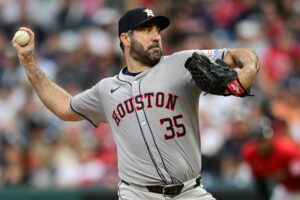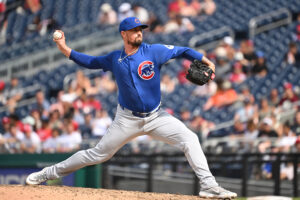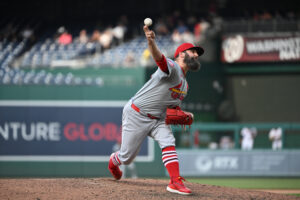Daniel Vogelbach has been one of the most polarizing figures among Mets fans in recent years. He drives fans crazy with his approach at the plate and minimal skillset. The Mets initially acquired him to increase run production with power and great on-base ability from the DH spot. However, he hasn’t shown much power during his Mets tenure and seemingly looks to walk, not hit, during every plate appearance. When he does walk, his lack of speed and athleticism makes him pretty stagnant on the bases. Despite his disappointing tenure, the Mets should tender Vogelbach this winter because it makes little sense to get rid of him right now.
Mets Should Tender One-Dimensional Veteran
Contract Status
Vogelbach has over five years of service time, meaning he is under team control for one more season through arbitration. The Mets have until November 17 to determine if they want to offer Vogelbach a contract. At this point, the two sides can negotiate and finalize an agreement. (likely a one-year deal) or go to arbitration.
MLBTradeRumors projects him to earn around $2.6 million in arbitration. However, this potential contract will not be fully guaranteed. If the Mets release him by a certain point in Spring Training, they will only owe a small percentage of the deal. Last year, Steve Cohen was willing to cut Darin Ruf before Opening Day and eat $3.25 million. If Vogelbach doesn’t look like he’d be a good fit on the team after a few weeks of Spring Training, Cohen would likely be willing to eat less than a million dollars to release him.
2024 salary projections for the Mets' arbitration-eligible players:
🔸 Pete Alonso: $22M
🔸 Daniel Vogelbach: $2.6M
🔸 Drew Smith: $2.3M
🔸 David Peterson: $2M
🔸 Joey Lucchesi: $2M
🔸 Trevor Gott: $2M
🔸 Luis Guillorme: $1.7M
🔸 Elieser Hernández: $1.6M
🔸 Tim Locastro: $1.6M… pic.twitter.com/tuZLVsd5n4— SNY Mets (@SNY_Mets) October 6, 2023
The Mets should tender Vogelbach because his contract is cheap and not guaranteed. If a free agent, he will likely sign a similarly inexpensive deal and make an Opening Day roster. Vogelbach possesses a skill that many new-age front offices desire and represents a low-risk, decent-value option. If the Mets find an upgrade, Vogelbach may have value as a minor piece in a trade this winter.
David Stearns must view Vogelbach through a creative lens and not rush to cut him for nothing.
Offensive Profile
The Mets significantly misused Vogelbach last year, contributing greatly to the narrative surrounding him. The 30-year-old typically hit in the middle of the lineup, where he was expected to hit for power and drive in runs. However, he never hit for much power throughout his Mets tenure and failed as a run producer due to his approach at the plate.
Walks are valuable and have been proven to contribute greatly to a team’s overall run-scoring. Vogelbach’s ability to work counts and draw walks has value. However, perhaps it is better to contribute to runs than produce them. The Mets needed a slugger from the DH spot, someone who can produce runs with extra-base hits. That was never Vogelbach as a Met.
If Vogelbach had enough plate appearances to qualify, his walk percentage (13.2 percent) and Chase percentage (21.4 percent) would have been among the league leaders. Instead of writing Vogelbach in the middle of the lineup, the Mets might have benefitted from him hitting leadoff or at the very bottom. This is especially true considering Brandon Nimmo‘s power increase at the expense of some on-base.
Vogelbach Setting the Table
The Mets should tender Vogelbach to use him as a table setter in front of the big bats. Vogelbach has a 130 tOPS+ in 12 career starts as a leadoff hitter. That output considerably drops when he hits fourth (110 in 118 starts), fifth (104 in 110 starts), or sixth (86 in 69 starts). Though a small sample size impacts these numbers, it makes sense that a guy who works, counts, sees pitches, and takes walks would excel at leading off.
Additionally, his combination of on-base ability and slow speed makes him a great candidate to hit in front of sluggers. If he hit leadoff for the Mets, he’d be on base for Francisco Lindor, Pete Alonso, Francisco Alvarez, and Nimmo. Each member of that quartet hit 24 or more homers last year. Hitting Vogelbach leadoff increases the chances of a solo homer becoming a two-run homer. There is also a better chance of him scoring off an extra-base hit than a single.
The Mets can also utilize Vogelbach’s skillset as a pinch hitter. In close and late games, a long at-bat can increase the pressure on a pitcher, defense, and opposing manager. The Mets would strategically manufacture this pressure by using Vogelbach to pinch hit.
The more pitches thrown in an at-bat, the more batters will see his stuff and be better prepared to hit. Furthermore, the pitcher is likelier to get tired, make a mistake, and get pulled sooner than expected. There’s value in having the opposing manager use more pitchers than he wants to. That’s not even mentioning the importance of having a runner on base in these close and late games.
The Mets should tender Vogelbach because they can choose any situation in the game to use him and put more pressure on the opponents.
Can He Hit For More Power?
Vogelbach not only got on base last year but also hit the ball hard. He was among the league leaders in Hard-Hit percentage (50 percent) and Average Exit Velocity (91.7 mph). A batter that hits the ball hard and gets on base should have good expected numbers.
Vogelbach gives the Mets the lead with that 2-run homer!
(via @Mets)pic.twitter.com/XTlPWADLaR
— FOX Sports: MLB (@MLBONFOX) July 22, 2023
For example, xwOBA (Expected Weighted On-base Average) indicates how a hitter should be hitting based on his contact and exit velocity. Vogelbach’s xwOBA was bad last year despite having great hard-it metrics. One possible conclusion is that a bad launch angle hurt him. An ideal launch angle in baseball is 15 to 20 degrees. Vogelbach averaged a 14.4-degree launch angle last year.
In the one season in which he hit more than 20 homers, he averaged a 17.1-degree launch angle. If he can adjust to get a little more lift on the ball, his value will skyrocket. A power hitter that controls the plate, while also not making much money provides possibly the most under-the-radar value on a roster. Vogelbach has this potential, and many teams will think they can get it out of him. There’s not real reason why the Mets need to give up just yet.
Conclusion
If the Mets tender Vogelbach, he can have a role on next year’s roster if used properly. Until he shows that he can consistently tap into his power, Vogelbach should contribute to run creation, not production. Teams must deploy this type of specialty player in a particular manner. This is similar to bringing in a lefty specialist out of the pen to face lefty hitters. Limited skillset players can thrive if used propethe .rly.
"If you want to have a future, you have to produce."
Daniel Vogelbach on his hot streak and what it could mean for him going forward with the Mets:https://t.co/zfNwFqEWa2
— Anthony DiComo (@AnthonyDiComo) August 23, 2023
It’s very possible the Mets find a similar on-base player that brings more to the table. However, the Mets shouldn’t make the move if it costs more than the cheap, non-guaranteed deal Vogelbach would sign in arbitration.
Vogelbach is not a perfect player and shouldn’t be irreplaceable. Even a guy who gets on base and plays average defense offers more value than Vogelbach. However, the Mets shouldn’t be too quick to release him without an obvious replacement. The Mets cut six players earlier this month. Vogelbach was not one of them. Perhaps Stearns, who previously acquired Vogelbach in Milwaukee, sees the value.
Main Photo Credits: Brad Penner-USA TODAY Sports






